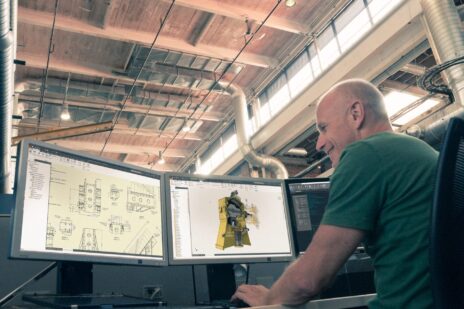

Creating 3D CAD models is one of the first steps in the design process. After you have a certain design, though, you need to validate that design through simulation. That means rendering complex meshes and letting your workstation run for often long periods of time. No one wants to wait weeks for large assembly files to render or calculate – that’s where model simplification comes into play.
Model simplification tools are great for speeding up simulations, lowering rendering times, and ultimately, protecting IP. In this post, we’ll take a look at some options you have inside of Autodesk Inventor for simplifying models for whatever your purpose might be to shave hours, days, or weeks off of your workstation runtime.
Preparing Models for Simulation
What you want: High-quality results, proper resolutions, and high simulation speed.
How to get there: Removal of small details, eliminate gaps and slivers, merge bodies, fill voids, utilize shrinkwrap, and adjust your level of detail (LOD).
The first step in the process of simplifying models is turning on your simplification tools in your Inventor toolbar. They aren’t there by default, so you’ll want to make sure they’re turned on for easy access in the process.
You ultimately want to simplify parts so that you can run simulations faster and run multiple simulations in the same amount of time as a more complex, but negligibly different simulation.
To do this simplification, you can use the create simplified part command, which creates the same part with individual bodies.
You can also use the define envelope command. This builds enormous voids overtop of components. This is good for if you want to share information and data and you only want the bounding box. First, it will show up as an envelope and then you can create a level of detail, and suppress unnecessary components.
Apart from these tools, you can also use the shrinkwrap or shrinkwrap substitute command. The main difference being the shrinkwrap command creates it’s own part file whereas the substitute command saves that part as a level of detail within your assembly file. These different file functionalities are good depending upon who you’re sharing the information with, internal or external. You can also select whether you want the simplified part associative or not.
Workflow: Complex Inventor assembly –> simplified part –> CFD/Mechanical/Moldflow/Nastran In-CAD
Reducing Size and Complexity for Rendering
What we want: faster render times, easy selection, render only what you need.
How we get there: selection tools, hide components, design views/LOD
When you’re rendering for a catalog, a brochure, a client, or whatever use you might need a high-quality render, you want to waste as little time as possible letting your computer do that task. In this process, one of the key things you can do is remove any parts in an assembly that don’t need to be rendered. Perhaps they aren’t seen in the render or don’t add any value, turning these files off through selection tools and design views will drastically improve your workstation run time.
Removing small details does help with the render time since those faces are not calculated during ray tracing. When we merge bodies and leverage the selection tool we can quickly apply materials prior to rendering. We also want to make sure we’re only rendering components that we want to render. We can use selection tools in combination with views to only render only the components we want in our current view.
Workflow: Complex Inventor assembly –> simplified assembly –> Ray tracing in Inventor
Protecting IP
When you have geometry that you want to share, but you just want to make sure that you have mounting holes and the center axis, then you need to use simplification tools to do so.
What you want: protect IP, don’t recreate data, easy collaboration
How we get there: remove details, merge bodies, hide components, shrinkwrap, file export
Protecting your intellectual property may be what most important aspects of your job. The last thing you want to do is to share information they can easily be redesigned and copied by a competitor. Engineers and designers need to share the information, but they need to share it intelligently and in a way that protects their information. One of the best ways to do this inside of Autodesk Inventor is with simplification tools.
One of the first things you probably want to do is to remove small details. This will not only make the files you are sharing smaller but I will also provide a quick and easy way to remove detail. Merging multiple bodies or components until one is also another way to protect the design intent of your products. Typically when your sharing your data it’s primarily used for clearance and placement purposes. In these cases, you can typically remove all internal components and futures.
Workflow: Complex Inventor assembly –> simplified part –> export to a neutral file format
This post was written referencing a class at Autodesk University 2018. You can read the handout for the class here.
Below is a list of commands referenced in this article linked to their help page (where applicable):
Shrinkwrap part • Create simplified part • Delete face • Direct edit • Remove details • Fill voids • Defend envelopes


